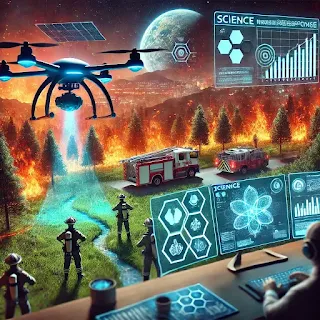Extreme wildfire seasons are becoming more frequent and devastating across the globe. From the Amazon rainforest to the forests of California, Australia, and the Mediterranean, wildfires are intensifying due to climate change, prolonged droughts, and human activities. While not all wildfires can be prevented, scientific advancements in data analysis, predictive modeling, and international collaboration are offering innovative ways to adapt and build fire-resilient communities.
This article explores how science and technology can help us mitigate the growing risks of wildfires, protect ecosystems, and ensure public safety in the face of worsening fire seasons.
The Rising Threat of Extreme Wildfire Seasons
1. Why Are Wildfires Becoming More Intense?
Wildfires are natural ecological events, but their increasing intensity is driven by several factors:
Climate Change: Rising global temperatures lead to drier forests, longer fire seasons, and extreme weather patterns.
Deforestation and Land Use Changes: Forest degradation, urban expansion, and agriculture increase fire vulnerability.
Accumulated Fuel Loads: Suppressing fires for decades has led to dense vegetation, providing excess fuel for large fires.
Human Activities: Over 85% of wildfires are caused by human actions, such as unattended campfires, power line failures, and arson.
2. The Consequences of Increasing Wildfires
The impact of extreme fire seasons goes beyond burned landscapes. Consequences include:
Loss of Lives and Property: Wildfires in populated regions cause fatalities, displace thousands, and destroy homes.
Air Pollution and Health Hazards: Smoke from wildfires increases respiratory diseases, especially in vulnerable populations.
Biodiversity Loss: Fires disrupt ecosystems, threatening endangered species and forest regeneration.
Economic Damage: Billions of dollars are spent annually on fire suppression, disaster relief, and rebuilding efforts.
How Science Can Help Us Adapt to Wildfires
1. Advanced Fire Prediction and Early Warning Systems
Modern fire prediction relies on:
Satellite Monitoring: NASA, ESA, and other space agencies use satellites like MODIS and VIIRS to detect fire hotspots and track fire spread in real time.
AI and Machine Learning Models: Algorithms analyze weather patterns, humidity, and historical fire data to predict high-risk fire zones.
Remote Sensing Technology: Drones equipped with infrared sensors can assess fire intensity and map potential fire-prone areas.
Early warning systems allow authorities to issue timely evacuation alerts and deploy firefighting resources efficiently.
2. Data-Driven Fire Management Strategies
Scientific data helps in designing fire-resilient landscapes through:
Fuel Management Programs: Controlled burns and thinning excess vegetation reduce wildfire fuel loads.
Fire-Resistant Infrastructure: Using fire-resistant materials in buildings and creating buffer zones protect communities from spreading fires.
Weather Forecasting for Fire Risk Assessment: Predicting wind patterns, temperature fluctuations, and drought conditions allows better firefighting preparedness.
3. Fire-Adapted Ecosystems and Reforestation Efforts
Not all wildfires are destructive—some are necessary for ecological balance. Science supports:
Restoration of Fire-Resilient Forests: Planting native species adapted to fire-prone regions helps in natural regeneration.
Regenerative Agriculture and Land Use Planning: Sustainable land management reduces fire risks while maintaining biodiversity.
Carbon Sequestration Strategies: Forests act as carbon sinks, and strategic reforestation helps offset emissions from wildfires.
International Collaboration in Fire Management
Wildfires are a global crisis that require international cooperation. Key initiatives include:
The Global Fire Monitoring Center (GFMC): Provides real-time wildfire data and promotes global fire prevention policies.
Cross-Border Firefighting Agreements: Countries share expertise, firefighting aircraft, and emergency response teams during large-scale fire disasters.
Knowledge Exchange Programs: Scientists and policymakers collaborate on best practices for wildfire resilience.
The Role of Technology in Firefighting
1. AI and Robotics in Fire Suppression
Autonomous Drones: Equipped with thermal imaging, drones help firefighters locate hotspots and direct water drops with precision.
AI-Powered Fire Simulation Models: These models simulate fire spread scenarios to optimize firefighting strategies.
Remote-Controlled Firefighting Vehicles: Designed for hazardous environments, these vehicles reduce firefighter risks.
2. Smart Firefighting Gear and Equipment
Heat-Resistant Drones: Used for real-time aerial surveillance of fire-prone areas.
Wearable Tech for Firefighters: Smart helmets and thermal-resistant suits enhance safety in extreme fire conditions.
Fire Detection Sensors: Installed in forests, these IoT-based sensors detect smoke and temperature anomalies, triggering early alerts.
Community-Based Fire Prevention Strategies
Public awareness and preparedness are crucial in reducing wildfire risks. Key strategies include:
1. Community Fire Safety Education
Governments and NGOs conduct awareness campaigns on safe campfire practices and fire prevention methods.
Homeowners are encouraged to create defensible spaces by clearing flammable vegetation near houses.
Schools integrate fire safety drills and emergency evacuation plans.
2. Strengthening Local Fire Response Teams
Training and equipping volunteer firefighting teams in rural and high-risk areas.
Establishing fire brigades that work alongside professional firefighters during emergencies.
Providing funding for local fire stations to ensure rapid response capabilities.
3. Policy and Governance for Fire Management
Governments should enact strict fire regulations and enforce penalties for negligence leading to wildfires.
Zoning laws should restrict construction in fire-prone areas to minimize property damage risks.
Investment in fire insurance programs can support affected communities in post-fire recovery.
The Future of Wildfire Management: A Call to Action
As extreme fire seasons loom, we must shift from reactive firefighting to proactive fire management. Key actions needed include:
✅ Strengthening fire monitoring and early warning systems through AI and satellite technology. ✅ Investing in sustainable forestry practices that prevent uncontrolled wildfires. ✅ Developing international policies to support fire prevention and disaster recovery. ✅ Encouraging scientific research on climate-resilient landscapes and fire-resistant infrastructure. ✅ Educating communities on fire prevention and preparedness measures.
Conclusion: A Fire-Resilient Future is Possible
Wildfires are a growing threat, but science and technology provide powerful tools to predict, manage, and mitigate their impact. By leveraging data, AI-driven models, and community-based strategies, we can adapt to extreme fire seasons and protect both people and ecosystems.
The road to a fire-resilient future requires collaboration—between governments, scientists, industries, and communities. With the right investments and proactive policies, we can ensure that wildfires remain natural, manageable events rather than catastrophic disasters.

No comments:
Post a Comment